JOIN TODAY
Yes! Keep me updated about the animals at CWC
Enter your email address for the chance to win a private tour of CWC
Your information will never be shared with a third party
By Dr. Stephany Lewis, Veterinarian
On the morning of December 30th, CWC received an adult female Red-Tailed Hawk from Newbury Park with evidence of anticoagulant rodenticide toxicosis (rodenticide poisoning). Raptors are exposed to rodenticides by ingesting poisoned rodents, and it leads to an inability to clot their blood, resulting in massive and often fatal blood loss. Our Hawk patient had multiple bruises on her body, was actively bleeding through a tiny puncture wound on her toe, and was severely anemic. We performed a crude test that quickly helps support a diagnosis of anticoagulant rodenticide toxicosis; we pulled a small amount of blood from the bird and placed it in an additive-free tube. Normally, a Hawk’s blood should clot within 2-5 minutes in the tube; our patient’s blood did not clot until the next day!
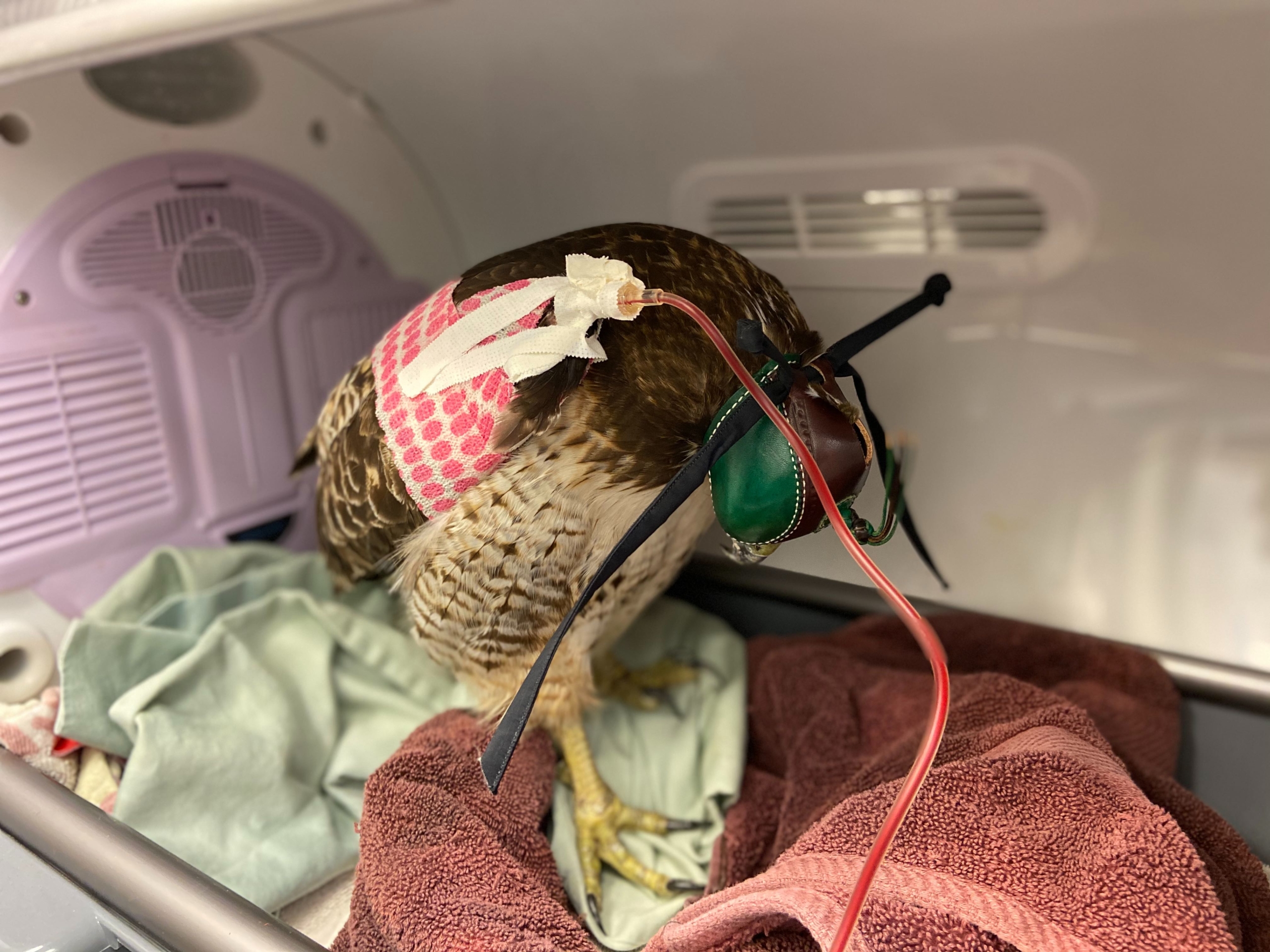
Hawk 3859 receiving a blood transfusion, photo by Cambria Wells
I decided to attempt a treatment that I had not performed since I was a dog and cat veterinarian; I opted to give this bird a blood transfusion. For a blood donor, we used another systemically healthy adult female Red-Tailed Hawk who had been in our care for about two months, but still had at least a few weeks to go in her rehabilitation process. She was briefly placed under anesthesia, and a unit of blood (which for her size is about 10 mL) was drawn from her jugular vein into a syringe with a special anticoagulant in it commonly used for blood transfusions. Our donor bird recovered extremely well, and no negative effects from the blood donation were seen.
Our recipient bird had a catheter placed into her right ulna. For birds, intraosseous catheters (catheters placed into the bone) tend to be more reliable than intravenous catheters since bird veins are very small and fragile, and the medullary cavity (marrow) of most bones (except the “hollow” ones that are continuous with their air sacs) are directly connected with their blood vessels.
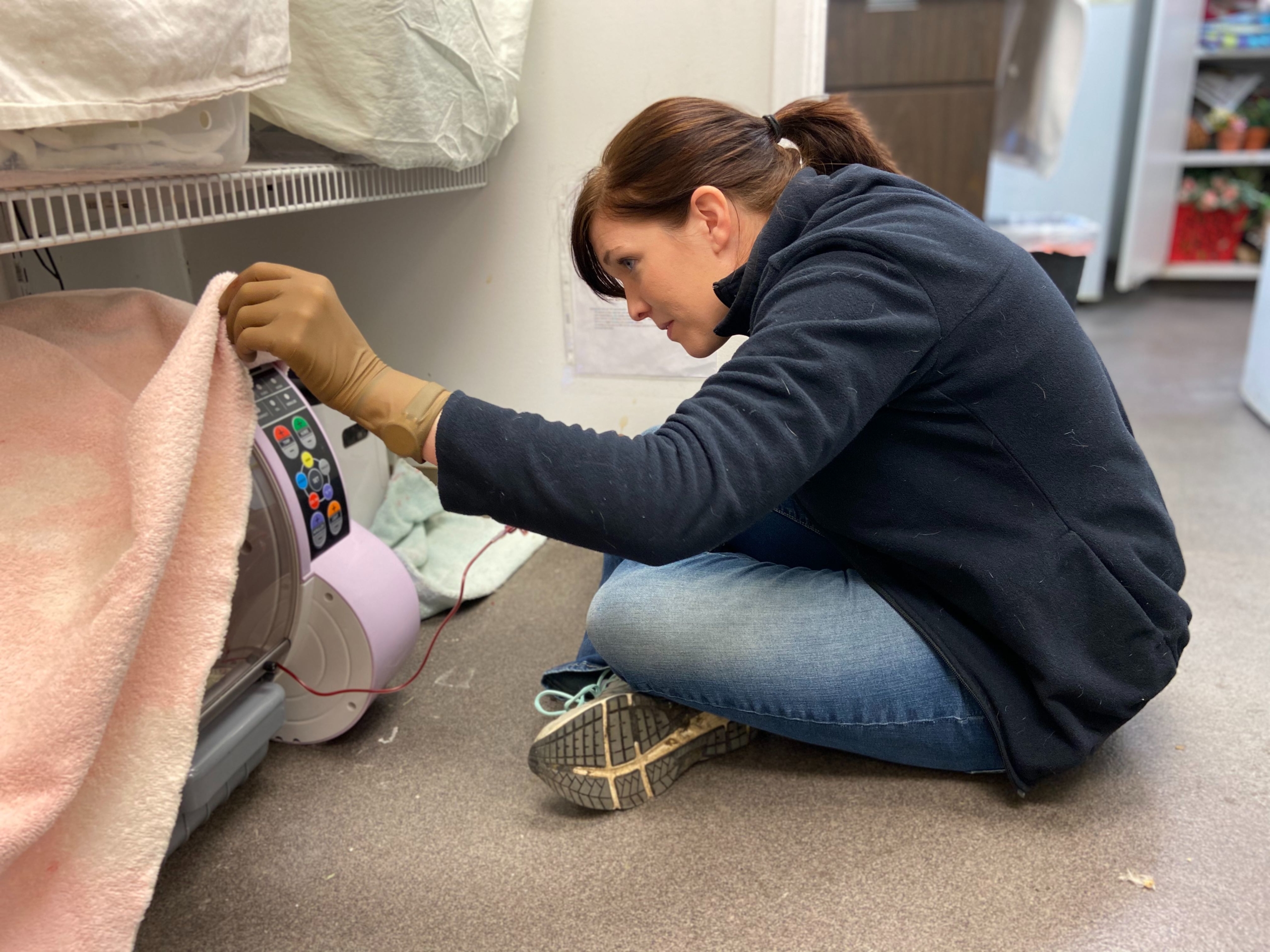
Dr. Lewis administering blood transfusion, photo by Cambria Wells
The blood was slowly given through a blood filter and into the intraosseous catheter. The Hawk began to perk up towards the end of her blood transfusion and started to nibble at the line, so we placed a falconry hood to keep her calm and keep her from fussing with her catheter and line. She completed her blood transfusion without any complications and was administered fluids for the rest of the day through her catheter. Her catheter was removed that evening. We also started her immediately on vitamin K, which is an antidote to this type of rodenticide.
The next morning, I received a message from one of our technicians describing this bird as “salty.” And indeed she was! She was bright, alert, quite feisty, and significantly less anemic! I had never seen such marked improvement so quickly in a patient suffering from rodenticide. From then on, her recovery was smooth sailing; she was able to live in one of our outdoor flight pens while completing her therapy, and the vitamin K was just hidden in her diet. The vitamin K is always administered for a full month, until the rodenticides should have cleared the body. Her anemia quickly resolved, and her blood was able to clot normally after discontinuing the vitamin K. After a couple of weeks reconditioning in our largest flight pen, she was successfully released back into the wild!
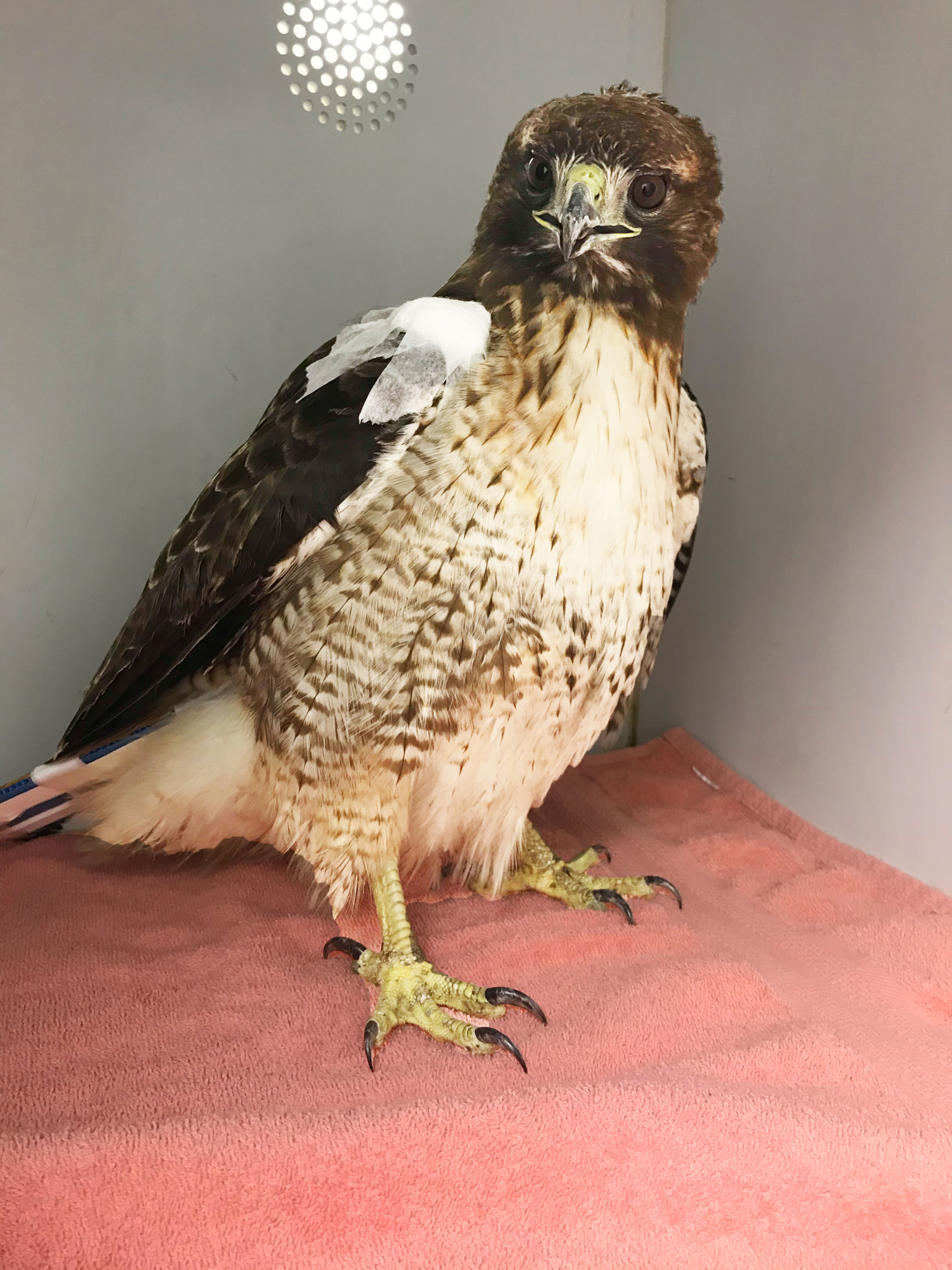
The blood transfusion recipient the next day, photo by Dr. Stephany Lewis
We were all so happy to have had such a successful outcome for this patient; however, many carnivores suffering from secondary rodenticide toxicosis do not have positive endings. CWC receives between 20 and 40 cases of secondary rodenticide poisoning yearly, and the success rate historically has been less than 10%. Almost all these patients perish in the first 12 hours, which is before our vitamin K therapy is able to take effect and stop their bleeding. In this case, the whole blood transfused not only provides life-saving oxygen and nutrients to their cells, but also replaces some of their clotting factors that have been inactivated by the rodenticide, so they can immediately stop the bleeding that is occurring. This is very helpful while we wait for the vitamin K antidote that we give to take effect, which takes 12-24 hours.
Our hope is that with this treatment, our success rate for patients suffering from these poisons will increase. The only challenge may be finding a readily available donor bird, as bird blood cannot be effectively stored for any significant amount of time. However, birds do not have any naturally occurring antibodies to blood types, so we can safely give a blood transfusion without typing or cross-matching and can even give blood from one completely different bird species to another without risk of a serious transfusion reaction. Though the best thing for our patients is for rodenticides not to be used at all, so they never need a transfusion in the first place! Please use poison-free alternatives for rodent control to protect all of our native carnivores!
Support CWC’s treatment of rodenticide-poisoned Hawks. Donate to the Have a Heart for Hawks campaign at cawildlife.org, mail in the enclosed envelope, or call us at (310) 458-9453, ext. 101.
By Cori Carlson, Administrative Assistant
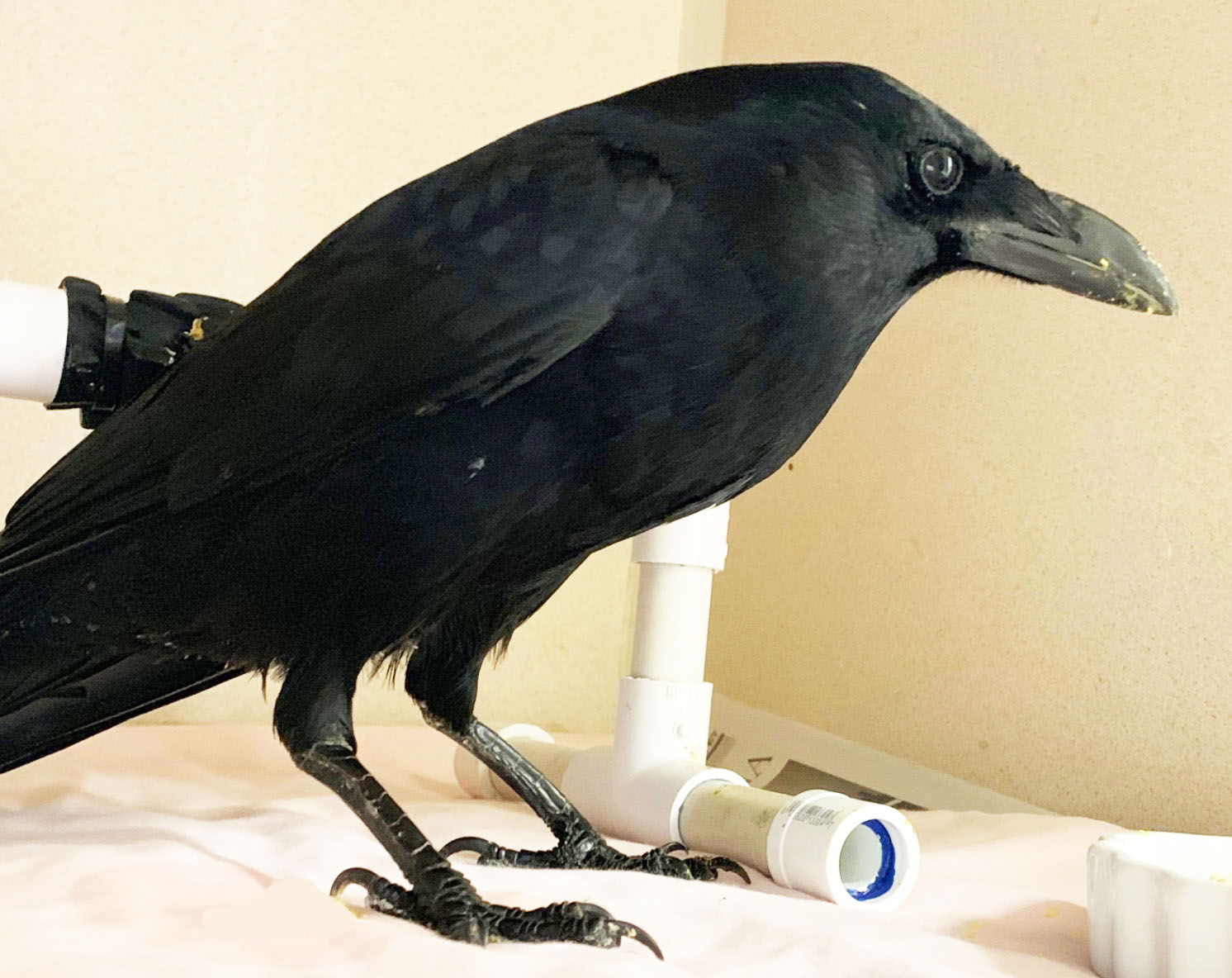
American Crow, Photo by Johanna Molina
Crows may not be the most popular of our native wildlife. But the black bird made famous in folklore and song lyrics is one of the most intelligent and an amazing problem-solver.
California Wildlife Center admits up to 175 species of birds each year, including American Crows. While CWC takes in adult Crows throughout the year, we start seeing babies in our Orphan Care Unit (OCU) in early May. Babies come to CWC when something happens to their parents, or they are injured. Last year, the OCU cared for 66 baby Crows.
While Crows are in care at CWC, we provide them with enrichment activities to keep them active and help them develop skills they’ll use back in the wild. While the younger Crows are inside a building, the staff put flowers in their cages and hang colorful, shiny materials with bells to encourage them to explore. When they are self-feeding and ready to move to larger outdoor enclosures, the staff have used dog-training toys with levers, slide doors, and slots for the Crows to open and find treats. CWC staff and volunteers also make homemade enrichment boxes, which they fill with shredded paper and hide treats for the Crows to find.
American Crows live across North America. While they prefer open spaces such as farmland and grasslands with trees nearby, they also live in suburban areas. Most types of Crows live in groups, called murders – a name that may not help with their popularity.
Crows are part of the Corvid family, which also includes Ravens and Jays. Since Crows and Ravens look similar, people sometimes confuse the two. Ravens are larger, have bigger beaks with a curve at the tip, their tails are wedge-shaped, and their wings come to a point. Meanwhile, a Crow’s tail feathers are the same length and look more like a fan when the bird’s in flight.
Typically, young Crows will be ready to leave the nest at four weeks of age, but they will continue to rely on their parents to feed them until they are about two months old. Crows are omnivores, which means they eat both plants and animals. Their diet in the wild includes grains, seeds, nuts, berries, fruit, insects, worms, and mice. Crows will also eat fish, eggs, and nestlings of other bird species.
When Crows come to CWC as orphans, they start with the corvid nestling diet, which is a blended mash of high-quality ground puppy food, hard-boiled eggs, bananas, baby food, vitamins, and minerals. As they get older, they transition to a Crow diet, which consists of bite-size pieces of high-quality dog food, hard-boiled eggs, fruits, vegetables, meat protein, vitamins, and minerals.
To give the Crows the best chance of making a successful transition back into the wild, CWC starts releasing them in groups of 9-15 birds beginning in August. This is the end of baby season when the Crows in the wild are less territorial. They start to join together in larger groups for the winter, known as communal roosting.
By Cambria Wells, Wildlife Technician
There’s nothing quite like seeing your baby experience the world for the first time. We are privileged at CWC in the Orphan Care Unit to get to work with a wide range of species and to see all their firsts. A few, this year, were especially touching.
First solid food: This year’s earliest litter of Virginia Opossums entered our facility too young to be out of their mother’s pouch. After weeks of careful care, they were finally old enough to be offered something more substantial than formula… and immediately made a mess of themselves! Staff and volunteers adapted by giving them supervised time with their food dish, breaks in the day that we quickly dubbed “mush bowl parties,” followed by a sponge bath.
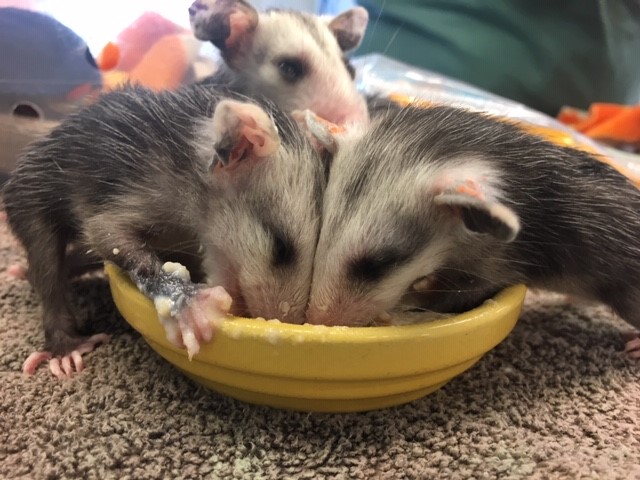
Opossum joeys eating their mush bowl
Photo by Cambria Wells
First steps: The Acorn Woodpeckers rescued from a fallen tree branch this summer were happy to stay in their nest box upon intake, but soon enough, their excitement for food led them to lean out the entryway to the box. One morning, that lean turned into a jump, and we caught a nestling’s first “branching” out into the world!
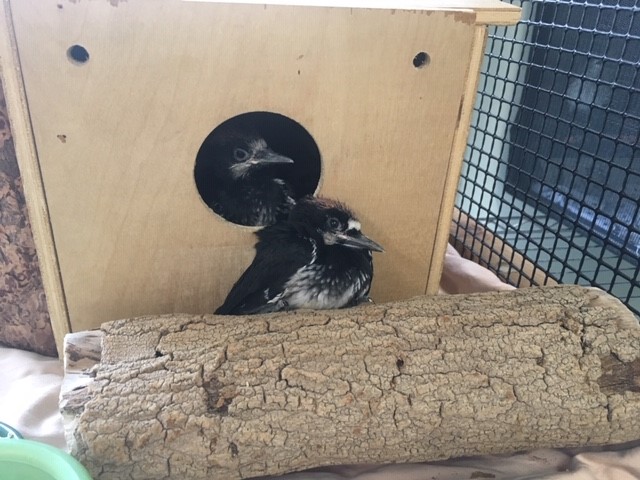
Acorn Woodpeckers peeking out of their nest box
Photo by Cambria Wells
First of their species: When workers brought down an electric pole in Santa Clarita this July, the crew heard crying from within an old woodpecker cavity inside. With the help of the wildlife biologist onsite, they extracted young Ash-throated Flycatchers from their disrupted nest and brought them to be raised in the Orphan Care Unit. These are the first of this species of bird ever to be raised at our facility.
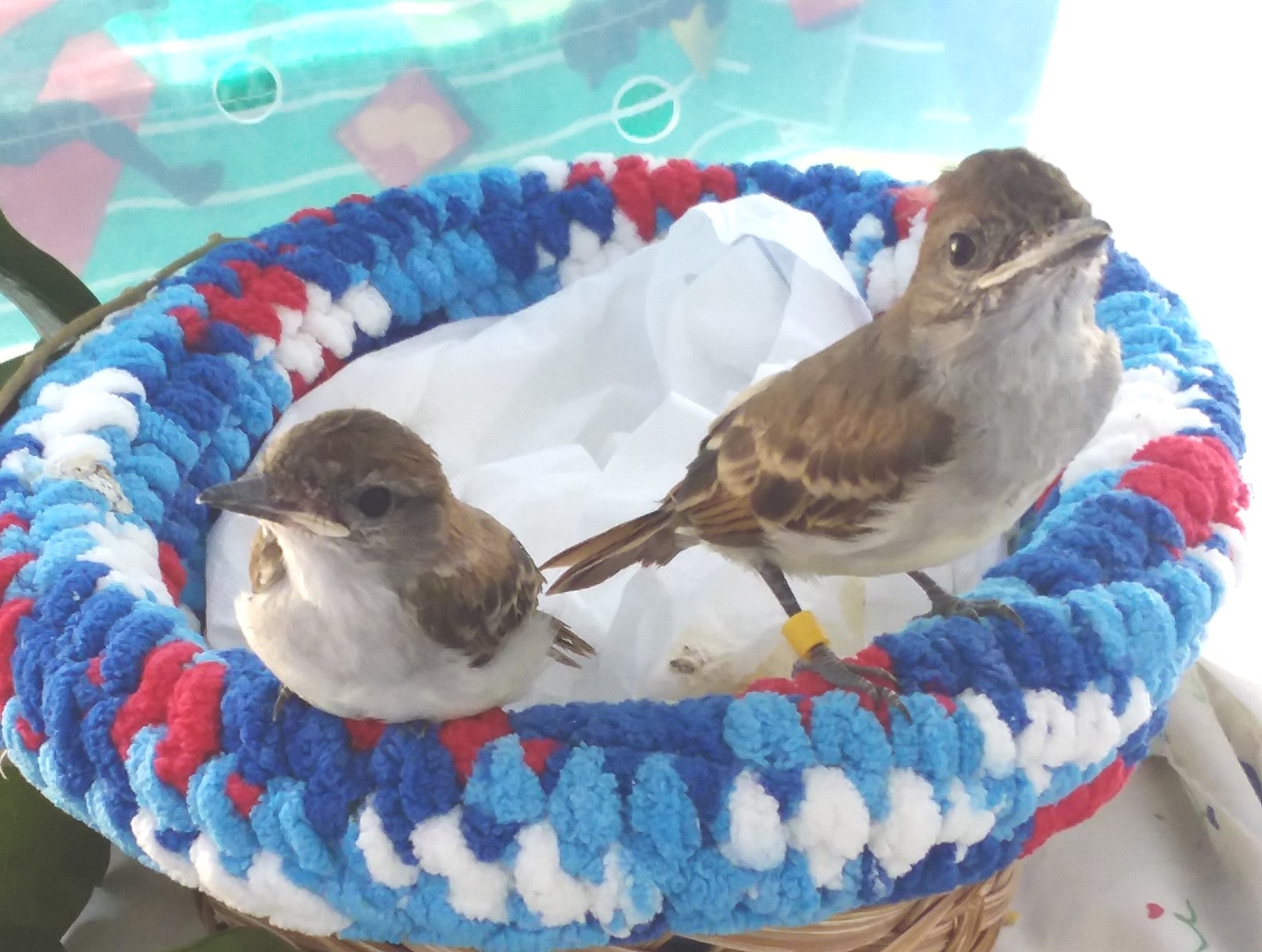
Ash-Throated Fly Catchers
Photo by Heather Patrice Brown
First friends: Many babies come into our care alone, displaced from their whole family. These animals are almost always placed with foster siblings; for certain highly social species like Eastern Fox Squirrels and American Crows, these friends are believed to be critical to their survival post-release. When released in a group, young animals have more eyes to find food and watch for predators. Volunteers and staff find these relationships to be touching glimpses into the lives of the animals we work with.
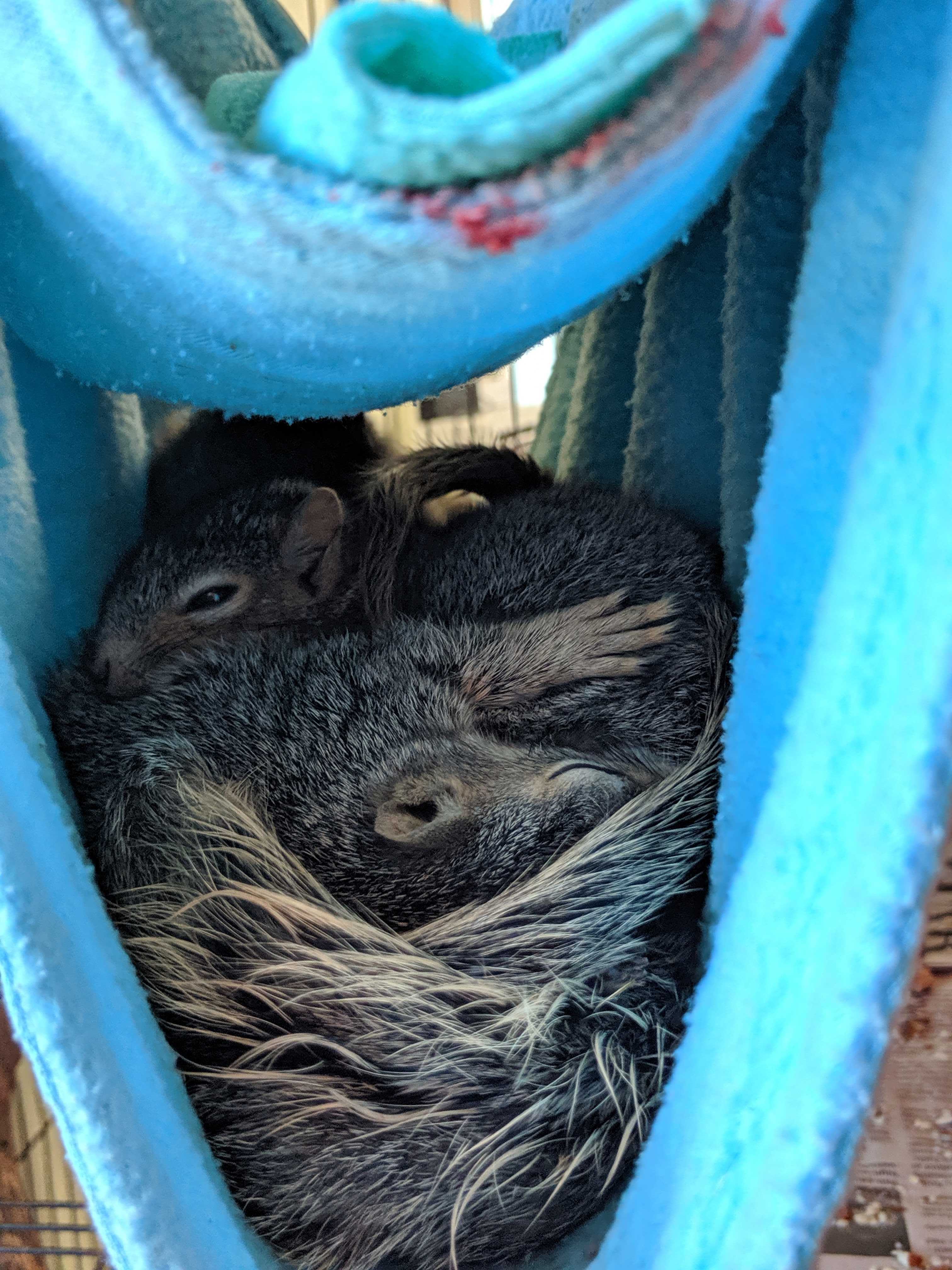
Squirrels napping together
Photo by Samantha Orzech
We are grateful to all CWC supporters for making these precious moments possible, and especially to our dedicated Orphan Care Unit volunteers for giving up their summers to help orphaned and injured wildlife. This year, Orphan Care supported a total of 1052 patients! Our impact, by the numbers:
Squirrels: 175
Mourning Doves: 138
Band-tailed Pigeons: 21
Northern Mockingbirds: 85
Virginia Opossums: 80
House Finches: 90
Cliff Swallows: 47
Hummingbirds: 141
American Crows: 66
Common Ravens: 30
And MANY assorted species of songbirds!
As the unit closes for the winter, we look forward to resting from the busy season and getting ready for next year, but of course, the rest of California Wildlife Center is here year-round for wildlife of all ages.
By Cambria Wells, Wildlife Technician
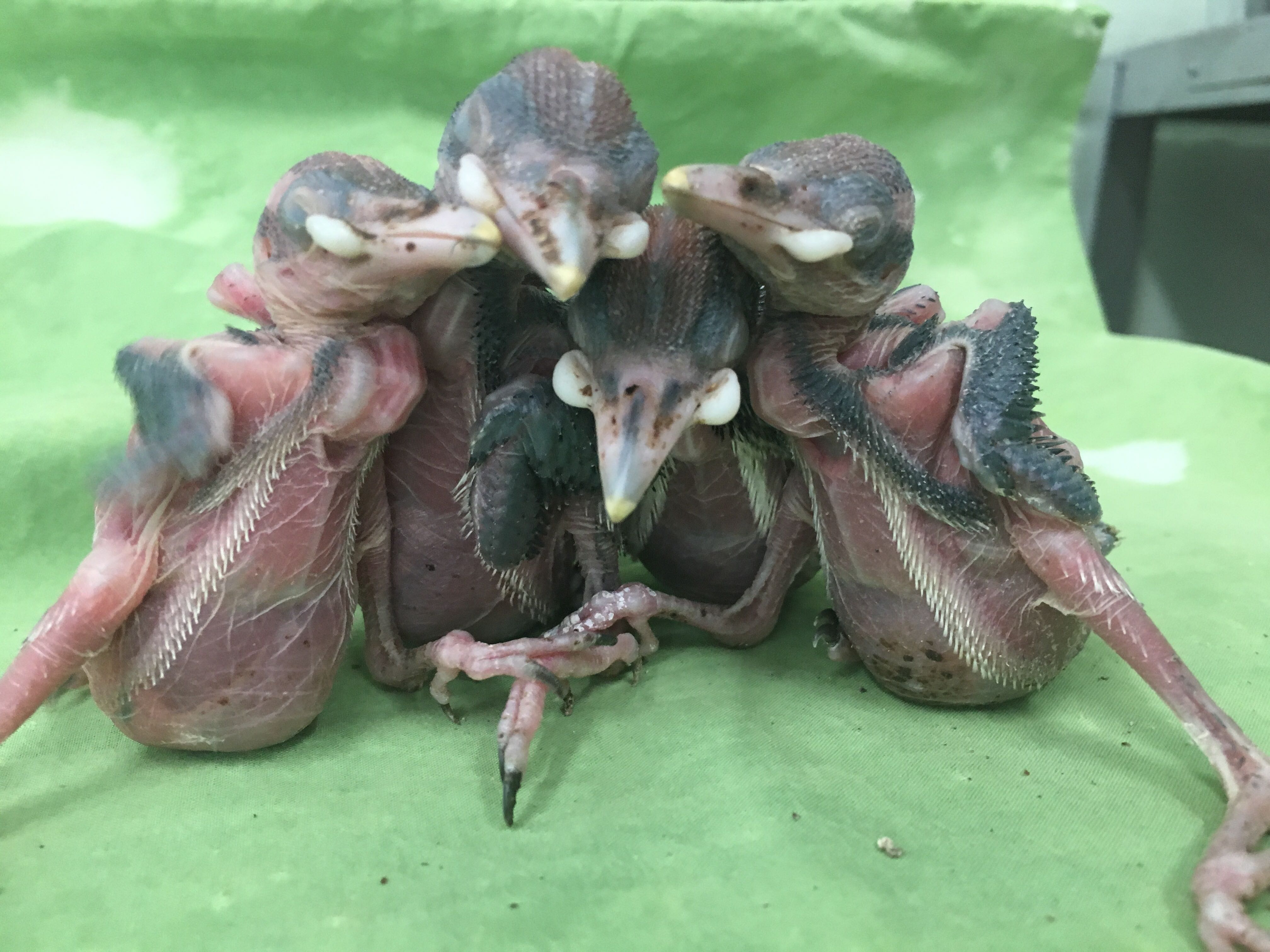
Acorn Woodpecker Nestlings
Photo by Cambria Wells
In early July, a Mimosa tree in Newbury Park cracked open, half the tree splitting apart at weak points created by years of Woodpecker activity. The homeowners had been expecting just such a thing to happen eventually; it had been assessed for removal in previous years but their affection for their local Woodpecker colony, which nested in the tree year after year, had driven them to keep the tree as long as they could. One such nest came down when the tree broke, dropping four naked, blind little nestling Acorn Woodpeckers into the sage planted below. Thanks to this soft landing and shade, the four babies were alive when the homeowners responded, collecting them and bringing them to California Wildlife Center for evaluation.
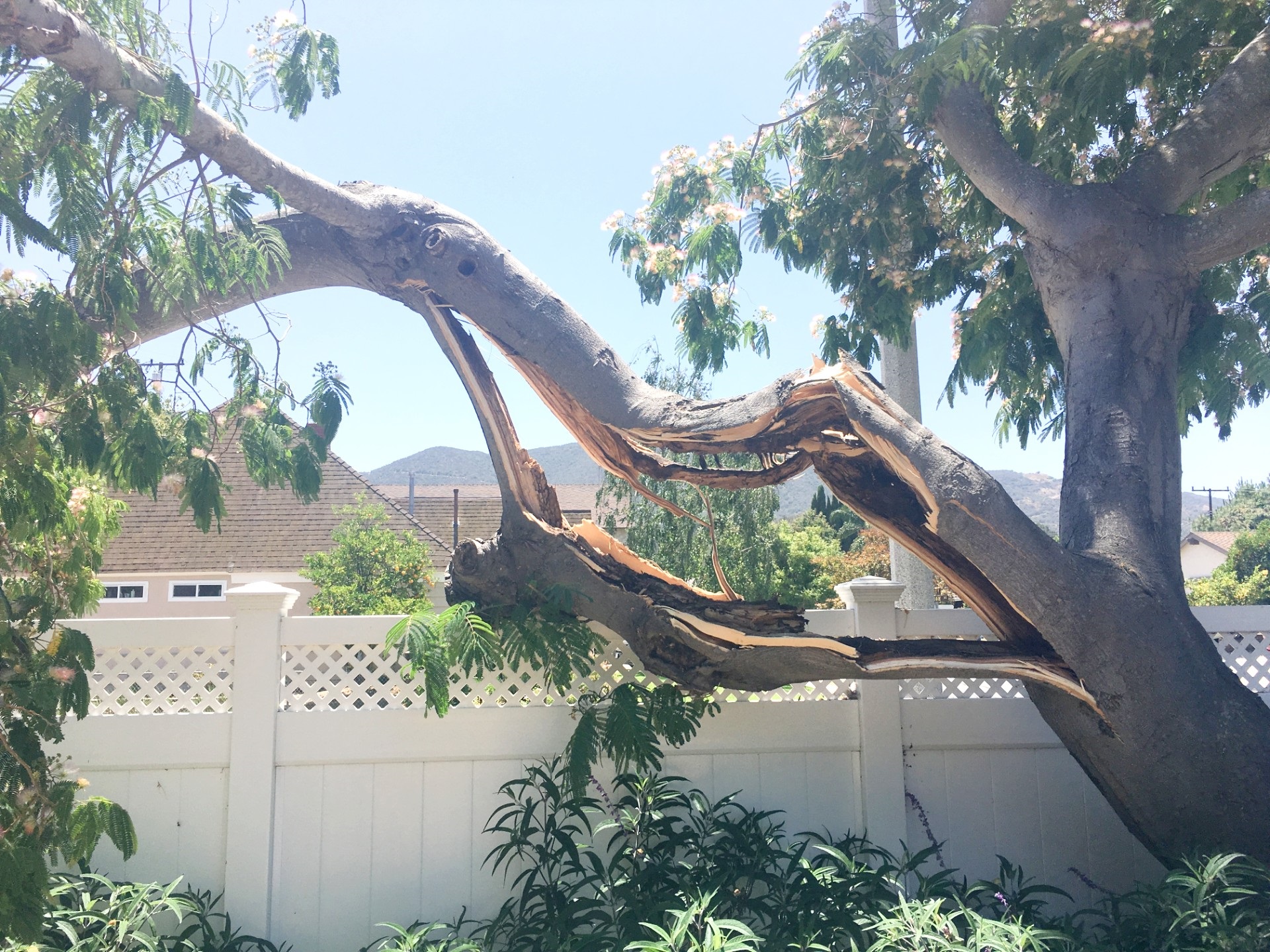
The Broken Tree Limb
by Cambria Wells
Though the Woodpeckers were uninjured, their home tree was still unstable and needed to be trimmed to prevent the destruction of a second nest in the tree. After fluid therapy and the initiation of feedings every thirty minutes, the four nestlings settled in for a hopefully temporary stay in an incubator at CWC. They proved to be excellent eaters with a very strict “pecking order” and regained their strength quickly. Four days later, with the Mimosa tree carefully trimmed to save the Woodpecker colony’s other nest, staff from California Wildlife Center responded to attempt to reunite the Woodpecker nestlings with their parents. The homeowners had observed four Woodpeckers providing food to another nest in the tree. In the absence of their own babies, it’s likely that the parents of the rescued Woodpeckers had turned to assisting their family members in the care of another nest.
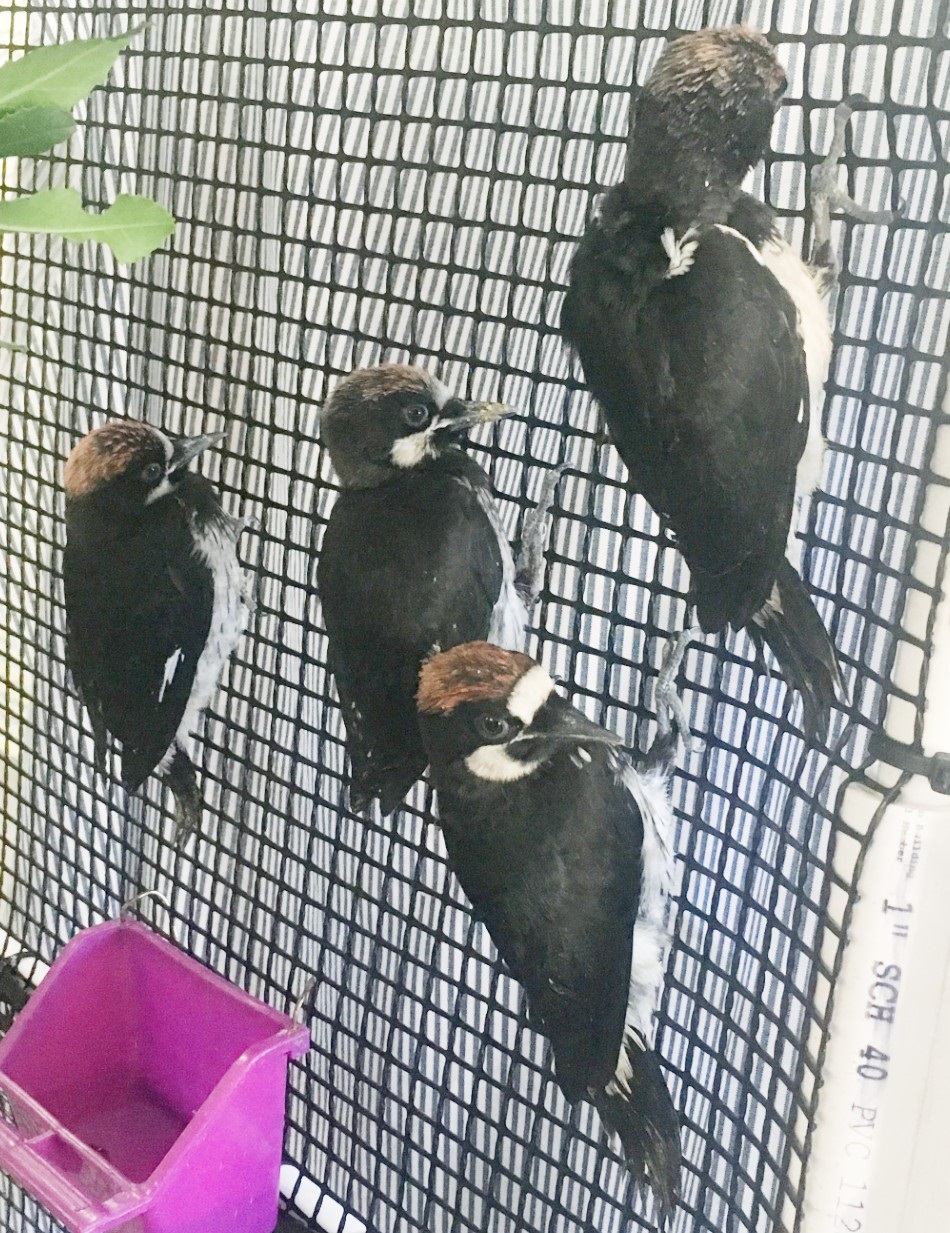
The Woodpeckers as Fledglings
Photo by Cambria Wells
Tree trimmers had saved the portion of the branch which contained the original nest, so CWC staff used heavy-duty straps to close the log and mount it on the Mimosa tree, as close to the original branch location as possible. The four rescued Woodpeckers were given copious amounts of food and water by mouth, then placed back in the nest cavity via the entry hole created by their parents. Unfortunately, despite the begging of the nestlings, they were not recognized by their family, and their parents did not approach to feed or care for them. Acorn Woodpeckers are highly territorial and family-oriented; the three days it took for the area to become safe to return the babies and the change in location of the nest were likely the reason the nestlings were not accepted back.
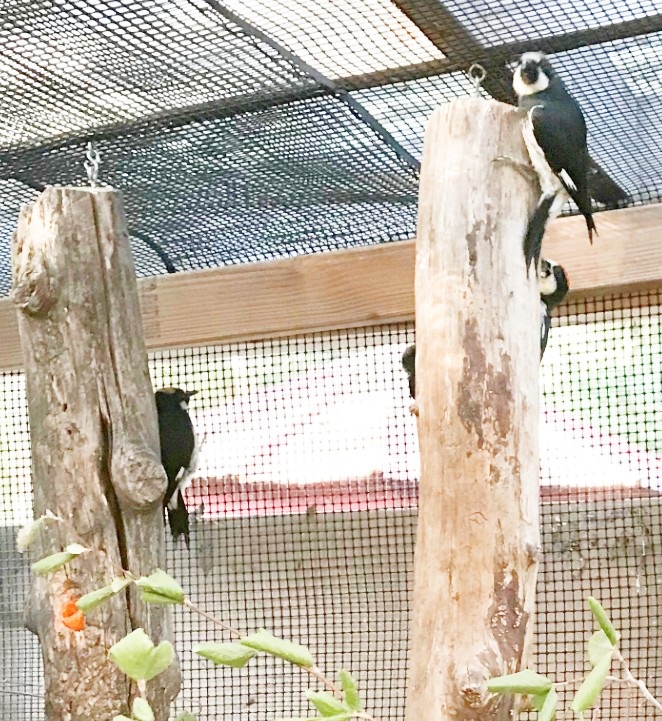
The Woodpeckers in Their Outside Enclosure
Photo by Denys Hemen
Luckily for the nestlings, they had a warm welcome waiting at California Wildlife Center. Staff extracted the four babies from the log and brought them back into care. Several weeks later they are all thriving fledglings, now fully feathered and able to fly, hop, and use their amazing bills and tongues like adults. They have been united with a foster family of five other individually orphaned Woodpeckers. Once all are self-feeding, this summer’s nine Acorn Woodpecker siblings will be moved to an outdoor enclosure to condition for soft-release in the oak forests of the Santa Monica mountains. There they will be fed and protected until they can integrate with a colony and be safely released.
By Dr. Stephany Lewis, Veterinarian
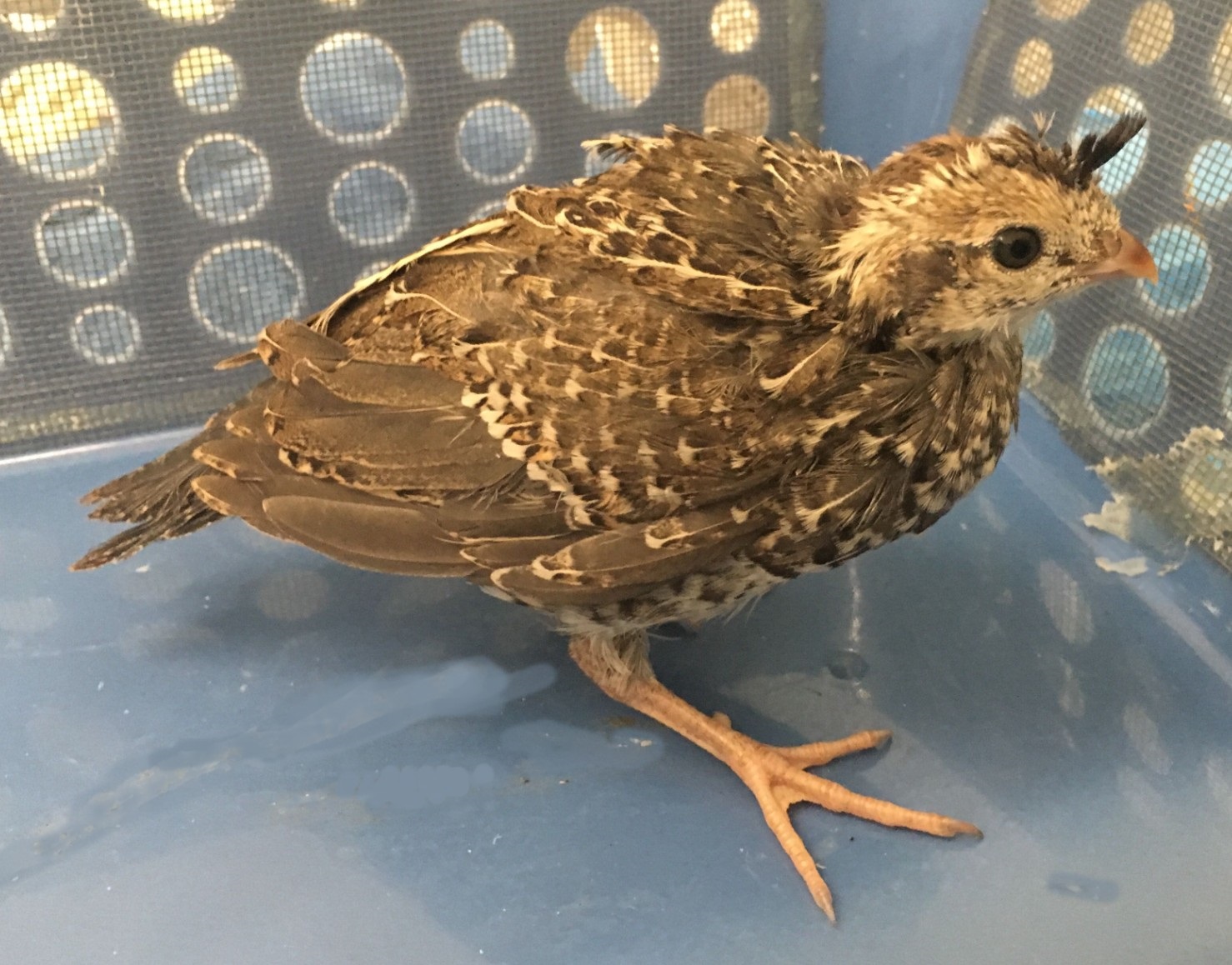
California Quail
Photo by Cambria Wells
Since May of 2018, Southern California, as well as parts of Arizona and Utah, have been impacted by a disease called Virulent Newcastle Disease (VND). Formerly known as Exotic Newcastle Disease, VND is an extremely contagious and deadly viral disease of birds. This virus can potentially infect humans but causes only mild conjunctivitis (inflammation around the eyes) and flu-like symptoms that resolve on their own without treatment. This disease primarily impacts poultry species, but no humans have been infected by eating poultry products.
The nervous and respiratory systems are most commonly affected in birds infected with VND. Clinical signs in infected poultry can include sneezing, coughing, nasal discharge, swelling around the eyes, depression, twisting of the neck, difficulty walking, and diarrhea. However, some birds may exhibit sudden death without any preceding clinical signs. Conversely, it is also possible for birds to be infected and shedding the disease without any signs of illness, particularly in psittacine birds (parrots). Some parrots can shed the virus for over a year. The virus is shed in respiratory secretions and feces of infected birds, and can be transmitted via contaminated people, feed, or equipment, as well as directly bird-to-bird.
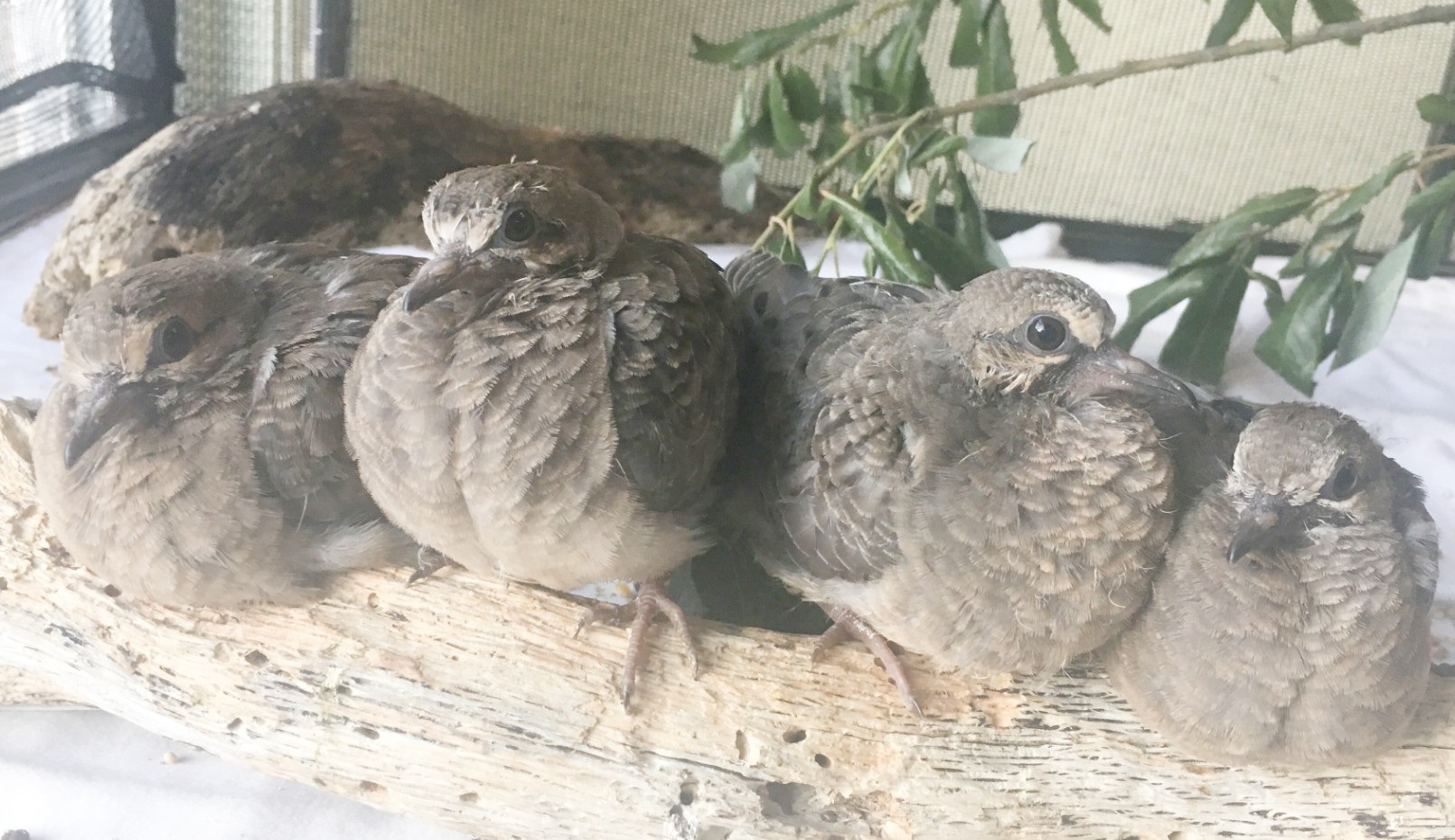
Mourning Doves
Photo by Cambria Wells
Sadly, there is no cure for VND, and prevention is only possible with stringent biosecurity measures. The California Department of Food and Agriculture (CDFA) have put in place strict quarantine and other biosecurity regulations, which can be found on their website at cdfa.ca.gov. These regulations have been significantly impacting both the commercial poultry industry, as well as backyard poultry owners within the quarantine zones of LA, Riverside, and San Bernardino counties. These regulations have also impacted us here at California Wildlife Center. Some of the regulations put forth by both the CDFA as well as California Department of Fish and Wildlife include prevention of the movement of wild poultry species if they have been housed at the same facility as domestic poultry species. Wild poultry species that we treat at CWC include Mourning Doves, Ducks, Geese, Band-Tailed pigeons, and Quail. Every year we have many patients transferred to us by LA county animal shelters; however, because these facilities house domestic poultry, they have not been allowed to transfer us any wild poultry species. Staff and volunteers who own birds at home also have had to practice some biosecurity measures, such as changing shoes and clothes.
Over 400 cases of VND have been confirmed, and over 1.5 million poultry have died or been euthanized due to the outbreak, but no new cases have been confirmed since August 30, 2019. For now, it is still important for everyone working with birds to continue practicing enhanced biosecurity, as the virus will remain in the environment for several more months, but hopefully, no new cases will be detected, and the disease is soon eradicated.
By Cambria Wells, Wildlife Technician
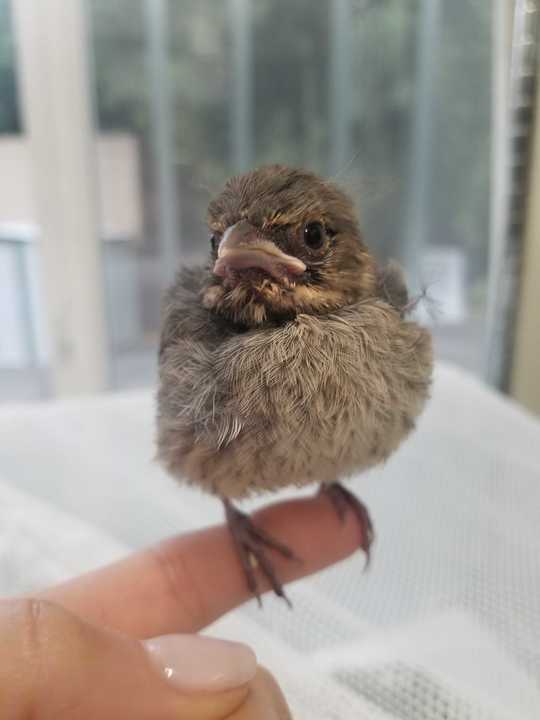
California Towhee Fledgling Photo by Brittany Moser
The rest of the world might have four seasons, but wildlife rehabilitation has even more. Busy season at California Wildlife Center begins with the opening of the Orphan Care Unit when squirrel kits, opossum joeys, and dove squabs begin to trickle in. We never know when the moment will strike, but it’s not long before everything changes again.
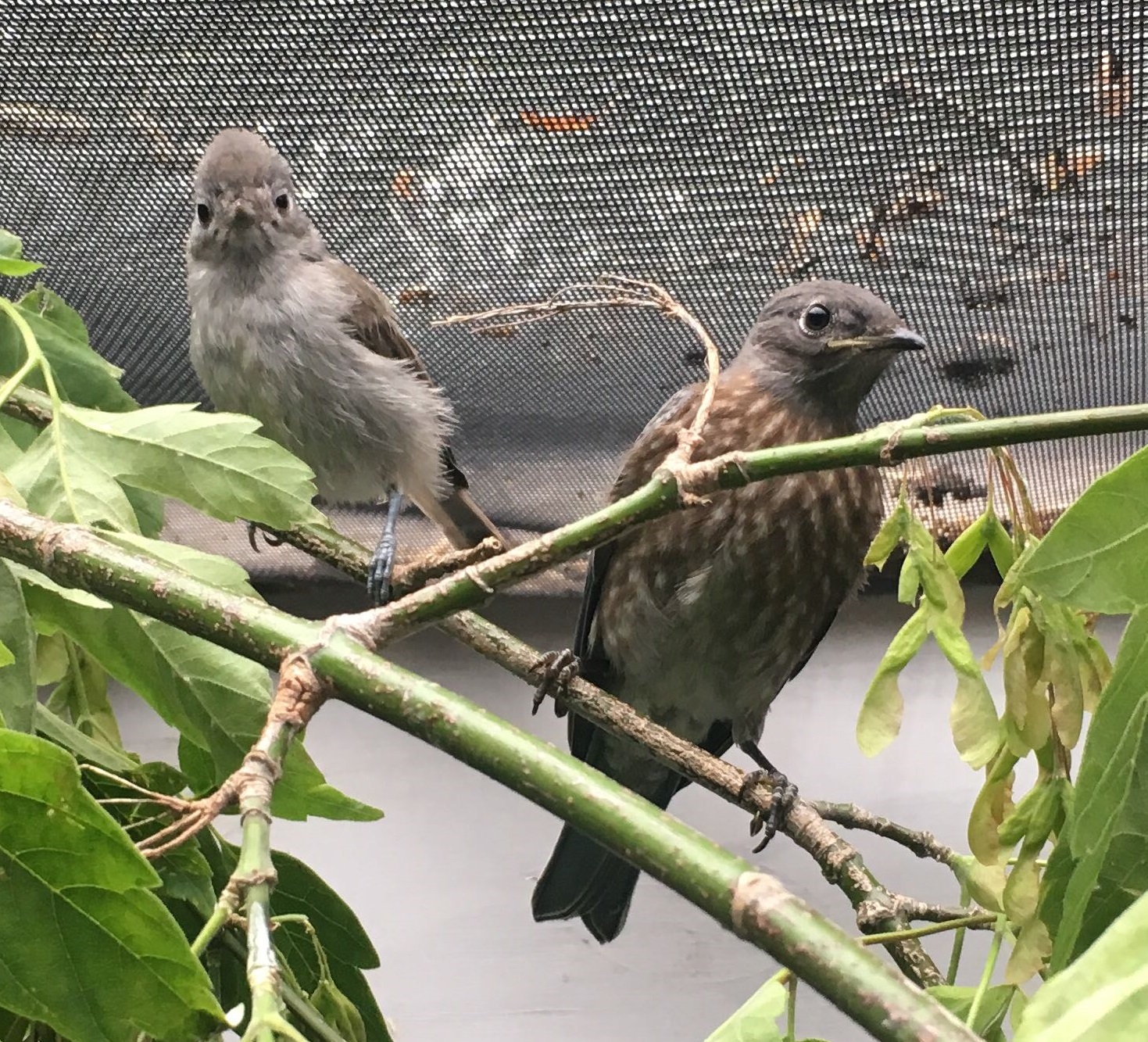
Oak Titmouse and Western Bluebird Fledglings
Photo by Cambria Wells
At the end of May, we’ve settled firmly into baby bird season, with a wide variety of species residing in Orphan Care and others moving into outdoor enclosures to strengthen their flight and condition for release. Our first songbirds are Northern Mockingbirds, California Towhees, House Finches, and Lesser Goldfinches, common backyard birds here in Southern California that quickly run into trouble with tree trimmers, outdoor cats, and windy day accidents. Next, we begin to see American Crows and Common Ravens, favorites of many CWC volunteers. After these familiar visitors arrive, we can never predict which other species will come in.
In 2017, the Orphan Care Unit was overwhelmed with a flood of young Northern Mockingbirds. In 2018, we provided supportive care to a large number of House Finches. Thus far, 2019 appears to be the season of variety. Orphan Care has already treated a number of species such as the Oak Titmouse, Western Bluebird, Bullock’s Oriole, Dark-eyed Junco, Black-headed Grosbeak, and more. Each of these species requires different care, from the unique nesting needs of Cliff Swallows and Wrens to the particular eating habits of Towhees and Bushtits. Some also enter into care with gastrointestinal parasites or wounds which require medical treatment. Volunteers and staff work each day to provide these birds the nutrition and stimulation they require, rapidly adapting to changing circumstances and patients.

Bushtit Fledgling
Photo by Brittany Moser

Black-Headed Grosbeak Fledgling
Photo by Cambria Wells
Over one weekend, the Orphan Care room can change completely, and your favorite patient can go from a nestling to a fledgling seemingly right before your eyes. In the two weeks a patient spends conditioning for release in an outdoor enclosure, they become completely independent, and their releases are a bittersweet victory. As each round of young animals moves on, we turn to the next and alter care to meet their needs again. The precious privilege of being involved in the early life of orphaned wildlife is only outweighed by knowing release means they’ll have a chance to raise their own young someday, in the wild, where they belong.
By Dr. Stephany Lewis, Veterinarian
This winter, CWC admitted an adult male Red-Shouldered

Red-Shouldered Hawk
Photo by Johanna Molina
Hawk after he was found on the ground in Santa Monica, too weak to fly. On physical examination, his only injury was a very small laceration on his toe, only about 5 mm in length, yet his feathers were completely soaked with blood and the laceration was actively bleeding. The mucous membranes in his mouth were pale white, and he was so weak that he couldn’t stand, wouldn’t open his eyes, and was barely responsive to external stimuli. A small amount of blood was collected from the bird for some basic bloodwork. He was found to be severely anemic, with 5 times less red blood cells than normal.
Sadly, those of us working in wildlife rehabilitation know that there is only one thing that could cause these clinical signs in a bird of prey. This bird was suffering from anticoagulant rodenticide toxicosis. Anticoagulant rodenticides are rat poisons that cause death to rodents by preventing their ability to clot their blood. Non-target species, such as Hawks, Owls, Bobcats, Coyotes, and Mountain Lions are exposed to these compounds by ingesting the rodents that have eaten these poisons. The poisons do not kill the rodents immediately, but rather slowly weaken them and make them easier prey. Some of these compounds, such as brodifacoum, difethialone, and bromadiolone, are known as “second generation anticoagulant rodenticides”. These compounds were invented in the 1970s in response to rodents becoming resistant to the “first generation” compounds, such as warfarin. One of the differences between the first and second generation rodenticides is also what makes the second generation compounds so much more dangerous for wildlife; they last for a very long time in the body. This means that non-target wildlife species can ingest multiple small doses over long periods of time until they build up levels high enough that they are no longer able to clot their blood. This has disastrous consequences. Animals can bleed into their lungs, causing severe distress, as well as into their brains, eyes, joints, and muscles, causing severe pain and permanent disabilities. Or, like our Red-Shouldered Hawk patient, they can lose all of their blood through what should be an inconsequential wound. Additionally, Bobcats and Mountain Lions are believed to suffer deleterious impact on their immune systems due to chronic exposure to these poisons, making them more susceptible to illness and death from infectious diseases such as mange.
Luckily for our Red-Shouldered Hawk patient, there is an antidote to these poisons, and it is just a simple vitamin, vitamin K. This treatment needs to be given daily for four weeks. Additionally, he received fluid therapy for the first week (a blood transfusion would be the preferred treatment but is unfortunately not an option for our unique patients). This bird actually had a catheter placed into a bone in his wing to quickly replenish blood volume and blood pressure after such drastic blood loss.
Forty-three days after he arrived, our Red-Shouldered Hawk had normal bloodwork, was well-conditioned, flying beautifully in one of our flight pens, and ready to be released! This was a wonderful outcome for this patient, but sadly most of the rodenticide victims who come to us are not as lucky. Because they arrive very late in the course of their illness, the majority of them pass away in the first 24 hours, before our vitamin K therapy has had time to work. Every patient who passes away due to rat poison is submitted for examination by biologists at the California Department of Fish and Wildlife to confirm the cause of death and aid research proving how damaging these poisons are to our native wildlife. The exposure frequency of wildlife to these compounds continues to be astounding, despite previous legislation made to limit their use. Scientists continue to detect these compounds in anywhere from 79 to 100% of animals tested, and in many cases, 3 – 6 different compounds are detected in the same individual.
Anticoagulant rodenticides pose a substantial and far-reaching threat to wildlife and ecosystem health. A California bill, AB1788, has reached the State Senate, and if passed will greatly restrict use of these poisons in our state. CWC is so grateful for everyone who has been working tirelessly to get this bill passed, and we hope you join us in urging your senator to pass this important legislation! Our wildlife deserves poison-free food!
By Cambria Wells, Wildlife Technician

This Long-Eared Owl suffered a wing fracture
Photo by Samantha Orzech
It’s the beginning of Owl breeding season, and the intensive care unit is
packed with an assortment of these special birds. Owls are among CWC’s most diverse patients; they encompass some of our largest and smallest raptor patients, come from a dramatic range of habitats and circumstances, and have some of the new year’s most impressive recovery stories.
A Long-Eared Owl rescued in Malibu this past December has just moved to an outdoor enclosure for conditioning. He was injured while overwintering in our area. The soft tissue damage around his wing fracture meant that his prognosis was guarded, but two months and several surgeries later he is flying with confidence and nearly ready to return to the wild. This Long-Eared Owl and a Western Screech-Owl, both current CWC patients, had part of an eye removed this month. Thanks to their highly sensitive hearing, these birds are adjusting well and will still be able to thrive and hunt in the wild upon release.

Barn Owl 19-62 arrived with a broken leg
Photo by Cambria Wells
Another CWC Owl patient, a Barn Owl, was admitted after the recent storms with two fractures to the tarsometatarsus bone in her lower leg. She was very wet and dirty from being found on the side of the road, leaving her weak and unable to thermoregulate. Her unstable condition and the proximity of the fracture to a joint made her surgery difficult, but thanks to Dr. Stephany Lewis’ work in pinning her bone she now has a brighter future ahead.
Our Owl patients display their will and vivacity by surviving head trauma, serious fractures, secondary poisoning and more. Currently, we are experiencing an influx of injured Owls as they compete for breeding partners. We will see another wave when orphaned Owlets begin to arrive in early March, and when juvenile Owls run into trouble after leaving their parents later this summer. Every one of these patients, and their healthy cousins beyond our walls, deserve all the care, conservation, and respect that we can offer as they live out their wild lives around us.
By Melissa Hartman

CWC sees many fledgling mockingbirds each year Photo by Jamie Pelayo
Mockingbirds sing one heckuva lot. You can hear them all year long, at
any time of the day, compiling sequences of repeated phrases, including riffs on calls made by other bird species. Like other songbirds, Mockingbirds’ songs are used mainly for courting or to defend territory.
Weighing in at a measly two ounces, a male Northern Mockingbird can produce several hundred phrases, picking up notes acoustically comparable to their own cadence and tone, including calls of other birds such as Jays, Hawks, Orioles, Robins and many others, as well as non-avian impersonations of dogs, cats, frogs—and even car alarms, cell phones and police sirens! They’re not called by their scientific name, Mimus polyglottos—”mimic of many tongues”—for nuthin’.
The Northern Mockingbird is one of 14+ Mockingbird species, many of which “mock,” but why? Some bird species imitate others to frighten their neighbors and steal their food; however, scientists have noted no change in behavior in birds imitated by Mockingbirds. Birds also are known to copy songs as a courtship strategy, but leading bird behaviorists cannot conclusively point to this as a hypothesis for why exactly Mockingbirds mock.
Last year at California Wildlife Center, Northern Mockingbirds were ninth of the ten most frequent species of the 4,300 animal patients seen. We took in 122 for a number of reasons: caught by cats, attacked by raccoons, with broken limbs, injured in window-strikes, orphaned.
As a CWC patient, the Northern Mockingbird is talkative and curious. It’s a pleasure to care for and release them to continue their amazing vocalizing in the wild!
P.O. Box 2022
Malibu, CA 90265
Hotline Phone: +1 310 458-WILD (9453)
E-mail: admin@cawildlife.org
Enter your email address for the chance to win a private tour of CWC
Your information will never be shared with a third party
